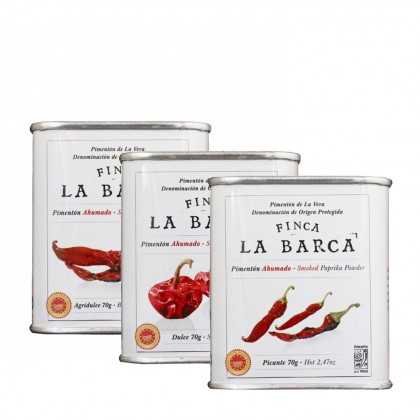Spanish paprika

Spanish Pimentón, paprika powder
Paprika powder is obtained by grinding dried peppers. Because, on the one hand, paprika fruits of different species are used and, on the other hand, the procedures are different, our kitchen has various flavors of paprika powder.
Paprika powder - history
All paprika species originate from Central and South America and have been cultivated there for millennia as crops. The oldest evidence for the use of paprika dates back to 7000 BC from Mexico.
In Europe, the paprika stopped until the end of the 15th century. A century when Christoph Kolumbus brought him from his supposed journey to India from America. Soon after the return of Columbus, the first paprika fruits were cultivated successfully in Spain, which is why they are still today in some areas of Germany “spanish pepper“.
In particular, it is thanks to the Portuguese that in the course of colonization and world trade the paprika fruit could spread throughout the world. Paprika powder as a spice is also widely used and is used from Spanish and Hungarian cuisine to French cuisine to German cuisine in many European countries.
Paprika Powder – Classification in Germany
In Germany, the Hungarian paprika powder is mainly commercially available. It is divided into different categories after its sharpness:
- Paprika powder extra sharp – the very sharp paprika powder for the lay is at a value above 500 with the degree of sharpness 1 on the Scoville scale. If you like to eat sharp, you can use it for both cold and hot dishes. However, it is difficult to obtain in Germany.
- Rose pepper – with its spicy aroma, the rose paprika (= paprika rosesharp) gives the final touch to particularly cold and hot dishes. It is very popular in Hungarian cuisine. On the Scoville scale, its value is between 100 and 500. The degree of sharpness indicated for rosepaprika is also 1.
- Peppers – even if the degree of sharpness of paprika powder is indicated half-sweet with 0, its value on the Scoville scale is still between 10 and 50. The half-sweet paprika is suitable for the not so sharp dishes of Hungarian cuisine.
- Paprika powder – the mild pepper powder tastes tenderly and almost a little sweet. With the sharpness 0, its value on the Scoville scale is between 0 and ten. It is suitable for aromatizing cold and hot dishes.
- Paprika powder Delikatess – with the degree of sharpness 0 and at the same time the value 0 on the Scoville scale, Delikatess Paprika is the mildest spice powder. Fruity, aromatic and sweet, it seasons cold and warm dishes with an interesting, delicate aroma. Even for the dietary kitchen, the gentle spice powder may be used.
Paprika Powder (Spanish Pimentón) – Classification in Spain
In Spain, paprika or paprika powder must not be considered from almost any hearty dish. However, the pepper powder is not only judged by the sharpness, but also by its aroma. You will find the following classification in three categories:
- Pimentón dulce - the sweet paprika powder is made from the paprika variety “La Bola” and is the most commonly used paprika spice. It is distinguished by its very mild, pleasantly spicy aroma.
- Pimentón picante – sharp pepper powder can be used for cold and hot dishes. It tastes spicy, aromatic and is very sharp.
- Pimentón agridulce – the sweet-heart paprika powder is NOT a mixture of sweet and sharp paprika, but is extracted from the “Ocal” variety. It tastes slightly sweet, but at the same time has a certain sharpness.
In addition, there is a division which depends on the production method of the powder:
- Pimentón – if no further information is given on the paprika powder, the ripe fruits were dried either with hot air or dried in warm areas, such as Murcia or Mallorca on the sun. In both cases, the paprika fruits subsequently ground to form powder have their natural, fruity and spicy aroma.
- Pimentón ahumado – the smoked paprika powder scores with the typical smoke aroma in addition to its natural, aromatic spice. The result is that the freshly harvested fruits are smoked for drying over hardwood.
Within Spain, the pepper powder is also distinguished by its origin:
- Pimentón de la Vera - the paprika powder from La Vera comes from the medium-sweet variety “Ocal” and is smoked for drying.
- Pimentón de Candeleda - the paprika powder from Candeleda also comes from the medium-sweet variety “Ocal” and is smoked for drying.
- Pimentón de Murcia – the pepper powder from Murcia is considered particularly mild. It is dried in the sun.
Season with pepper powder
Depending on which paprika powder you use, add it to the dish in different quantities and at different times. In order not to spoil food by too much sharpness, you should always carefully dose sharp pepper powder. Taste with the hot pepper powder only after the cooking process.
So that the mild pepper powder can fully develop its aroma, it needs fat as a flavor carrier. It is therefore added immediately after roasting or steaming and then fried with weak heat. Attention: Do not let the fat get too hot! Burn the pepper powder, it tastes bitter.
Very mild powder you can dose generously, because paprika powder is not only a spicy, but at the same time a binder that makes the sauce more soothing. The Spanish cuisine does not come out without paprika. The aromatic spice is also used in numerous German dishes. Paprika matches:
- Soups
- Sauces
- Meat
- Fish
- Seafood
- Egg dishes
- Cheese
- Salad
- Vegetables



